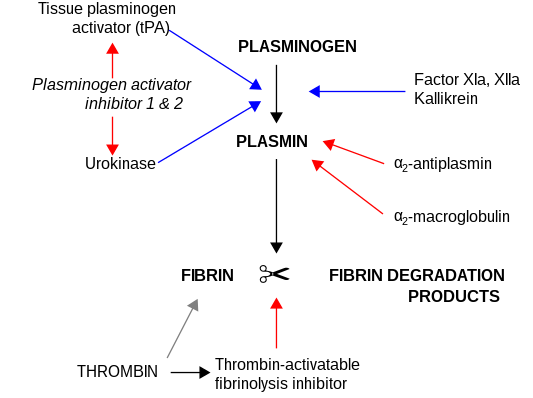Carboxypeptidase B2
| CPB2 | |||
|---|---|---|---|
Gene ontology | |||
| Molecular function | |||
| Cellular component | |||
| Biological process |
| ||
| Sources:Amigo / QuickGO | |||
Ensembl | |||||||||
|---|---|---|---|---|---|---|---|---|---|
| UniProt | |||||||||
| RefSeq (mRNA) | |||||||||
| RefSeq (protein) | |||||||||
| Location (UCSC) | Chr 13: 46.05 – 46.11 Mb | Chr 14: 75.48 – 75.52 Mb | |||||||
| PubMed search | [3] | [4] | |||||||
| View/Edit Human | View/Edit Mouse |
Carboxypeptidase B2 (CPB2), also known as carboxypeptidase U (CPU), plasma carboxypeptidase B (pCPB) or thrombin-activatable fibrinolysis inhibitor (TAFI), is an enzyme that, in humans, is encoded by the gene CPB2.[5][6]
Function
CPB2 is synthesized by the liver
Carboxypeptidases are enzymes that hydrolyze C-terminal peptide bonds. The carboxypeptidase family includes metallo-, serine, and cysteine carboxypeptidases. According to their substrate specificity, these enzymes are referred to as carboxypeptidase A (cleaving aliphatic residues) or carboxypeptidase B (cleaving basic amino residues). The protein encoded by this gene is activated by thrombin and acts on carboxypeptidase B substrates. After thrombin activation, the mature protein downregulates fibrinolysis.[10]
 |
Isozymes
Polymorphisms have been described for this gene and its promoter region. Available sequence data analyses indicate splice variants that encode different isoforms.[10]
See also
References
- ^ a b c GRCh38: Ensembl release 89: ENSG00000080618 – Ensembl, May 2017
- ^ a b c GRCm38: Ensembl release 89: ENSMUSG00000021999 – Ensembl, May 2017
- ^ "Human PubMed Reference:". National Center for Biotechnology Information, U.S. National Library of Medicine.
- ^ "Mouse PubMed Reference:". National Center for Biotechnology Information, U.S. National Library of Medicine.
- PMID 1939207.
- PMID 1427879.
- ISBN 978-0071621519
- S2CID 1803078.
- PMID 10350473.
- ^ a b "Entrez Gene: CPB2 carboxypeptidase B2 (plasma)".
Further reading
- Bouma BN, Mosnier LO (2005). "Thrombin activatable fibrinolysis inhibitor (TAFI) at the interface between coagulation and fibrinolysis". Pathophysiol. Haemost. Thromb. 33 (5–6): 375–81. PMID 15692247.
- Marinkovic DV, Marinkovic JN, Erdös EG, Robinson CJ (1977). "Purification of carboxypeptidase B from human pancreas". Biochem. J. 163 (2): 253–60. PMID 17398.
- Pascual R, Burgos FJ, Salva M, et al. (1989). "Purification and properties of five different forms of human procarboxypeptidases". Eur. J. Biochem. 179 (3): 609–16. PMID 2920728.
- Valnickova Z, Thogersen IB, Christensen S, et al. (1996). "Activated human plasma carboxypeptidase B is retained in the blood by binding to alpha2-macroglobulin and pregnancy zone protein". J. Biol. Chem. 271 (22): 12937–43. PMID 8662763.
- Bajzar L, Morser J, Nesheim M (1996). "TAFI, or plasma procarboxypeptidase B, couples the coagulation and fibrinolytic cascades through the thrombin-thrombomodulin complex". J. Biol. Chem. 271 (28): 16603–8. PMID 8663147.
- Vanhoof G, Wauters J, Schatteman K, et al. (1997). "The gene for human carboxypeptidase U (CPU)--a proposed novel regulator of plasminogen activation--maps to 13q14.11". Genomics. 38 (3): 454–5. PMID 8975730.
- Matsumoto A, Itoh K, Matsumoto R (2000). "A novel carboxypeptidase B that processes native beta-amyloid precursor protein is present in human hippocampus". Eur. J. Neurosci. 12 (1): 227–38. S2CID 26058321.
- Marx PF, Hackeng TM, Dawson PE, et al. (2000). "Inactivation of active thrombin-activable fibrinolysis inhibitor takes place by a process that involves conformational instability rather than proteolytic cleavage". J. Biol. Chem. 275 (17): 12410–5. PMID 10777524.
- Mosnier LO, Lisman T, van den Berg HM, et al. (2002). "The defective down regulation of fibrinolysis in haemophilia A can be restored by increasing the TAFI plasma concentration". Thromb. Haemost. 86 (4): 1035–9. S2CID 4080586.
- Mosnier LO, Meijers JC, Bouma BN (2002). "The role of protein S in the activation of thrombin activatable fibrinolysis inhibitor (TAFI) and regulation of fibrinolysis". Thromb. Haemost. 86 (4): 1040–6. S2CID 21500722.
- Mosnier LO, Elisen MG, Bouma BN, Meijers JC (2002). "Protein C inhibitor regulates the thrombin-thrombomodulin complex in the up- and down regulation of TAFI activation". Thromb. Haemost. 86 (4): 1057–64. S2CID 32258311.
- Morange PE, Aillaud MF, Nicaud V, et al. (2002). "Ala147Thr and C+1542G polymorphisms in the TAFI gene are not associated with a higher risk of venous thrombosis in FV Leiden carriers". Thromb. Haemost. 86 (6): 1583–4. S2CID 30051401.
- Schneider M, Nagashima M, Knappe S, et al. (2002). "Amino acid residues in the P6-P'3 region of thrombin-activable fibrinolysis inhibitor (TAFI) do not determine the thrombomodulin dependence of TAFI activation". J. Biol. Chem. 277 (12): 9944–51. PMID 11786552.
- Koschinsky ML, Boffa MB, Nesheim ME, et al. (2002). "Association of a single nucleotide polymorphism in CPB2 encoding the thrombin-activable fibrinolysis inhibitor (TAF1) with blood pressure". Clin. Genet. 60 (5): 345–9. S2CID 86724521.
- Yano Y, Gabazza EC, Hori Y, et al. (2002). "Association between plasma thrombin-activatable fibrinolysis inhibitor levels and activated protein C in normotensive type 2 diabetic patients". Diabetes Care. 25 (7): 1245–6. PMID 12087030.
- Antovic JP, Blombäck M (2003). "Thrombin-activatable fibrinolysis inhibitor antigen and TAFI activity in patients with APC resistance caused by factor V Leiden mutation". Thromb. Res. 106 (1): 59–62. PMID 12165290.
This article incorporates text from the United States National Library of Medicine, which is in the public domain.
